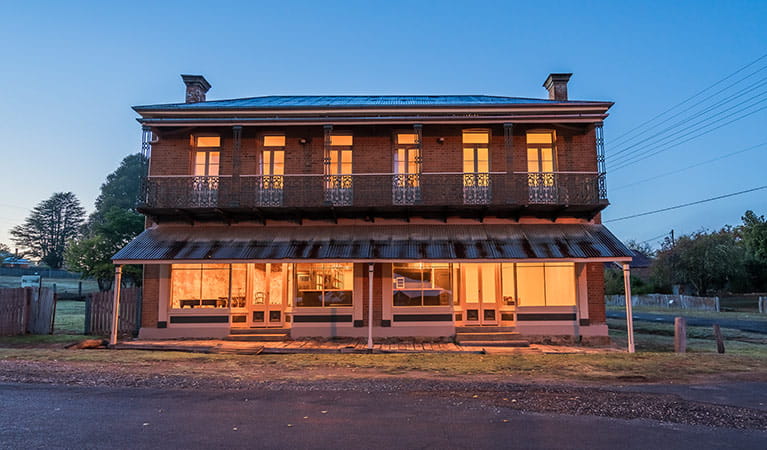Hill End Historic Site
Discover life during the gold rush at Hill End Historic Site and explore heritage buildings and mine relics. You can stay in heritage accommodation, or camp with your dog at dog-friendly campgrounds.
Read more about Hill End Historic Site
Step back in time at Hill End Historic Site and discover the enduring legacy of colonial New South Wales and the roaring early days of the gold rush.
Explore the town on a self-guided tour starting at the Hill End Heritage Centre, where you’ll find streetscapes and buildings with little changed since the village’s 1870s goldmining heyday. Public toilets and barbeque facilities are available throughout the village, simply follow the signage.
Take a virtual a tour of impressive Craigmoor House for an intriguing peek into the past, try your luck gold panning at the Fossicking Ground, and experience the subterranean world of a colonial goldminer on a guided tour of Bald Hill Tourist Mine.
Spend a couple of days uncovering the layers of history at this remarkable site, home to a thriving community and artists’ retreat. You can camp at one of two campgrounds or stay in heritage accommodation in town.
Part of a living village, Hill End Historic Site is also dog-friendly with your furry friend welcome at campgrounds, picnic areas and lookouts, and on public roads and walking tracks.
Local alerts
For the latest updates on fires, closures and other alerts in this area, see https://www.nationalparks.nsw.gov.au/visit-a-park/parks/hill-end-historic-site/local-alerts
Map
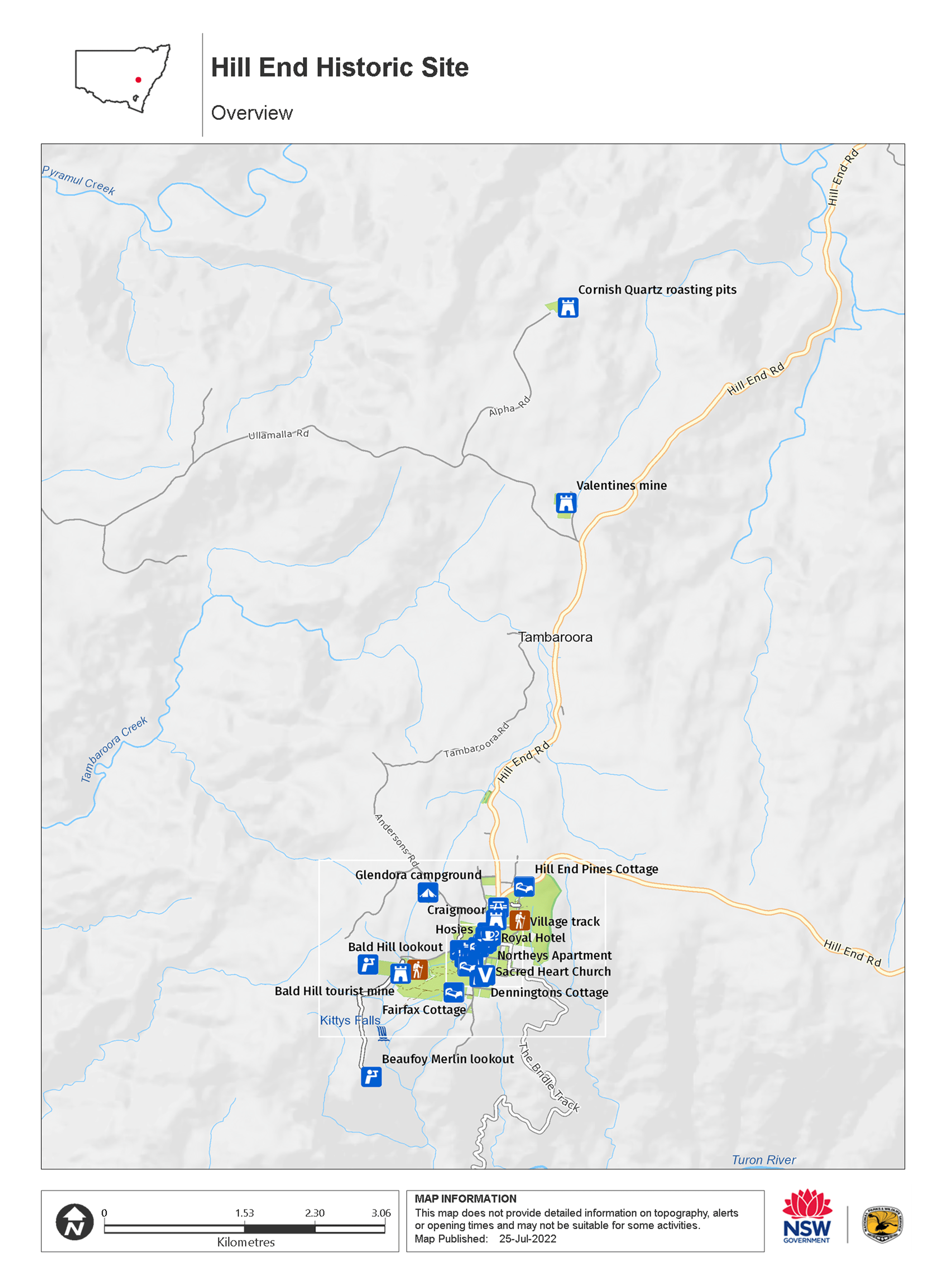
Map
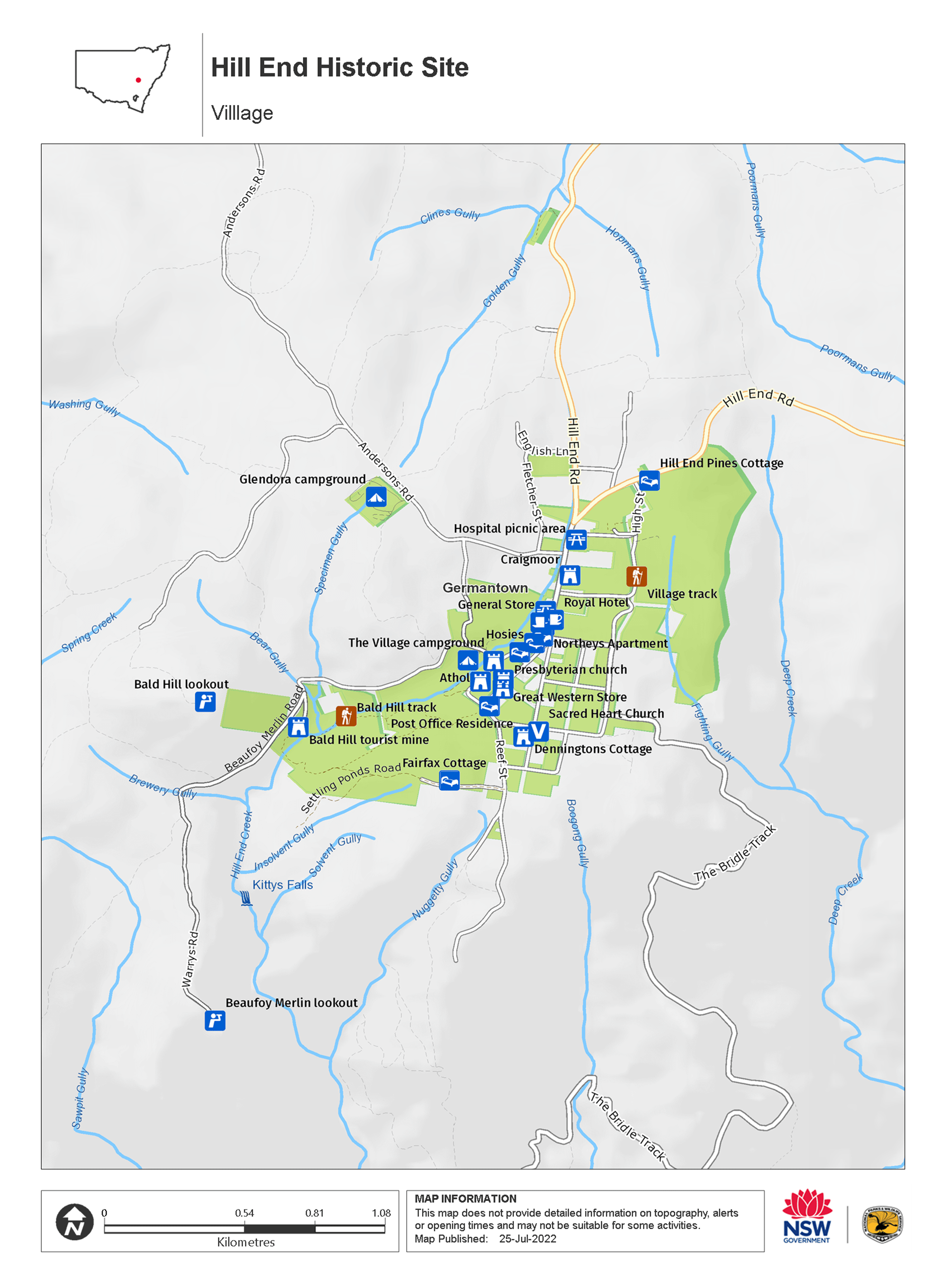
Map
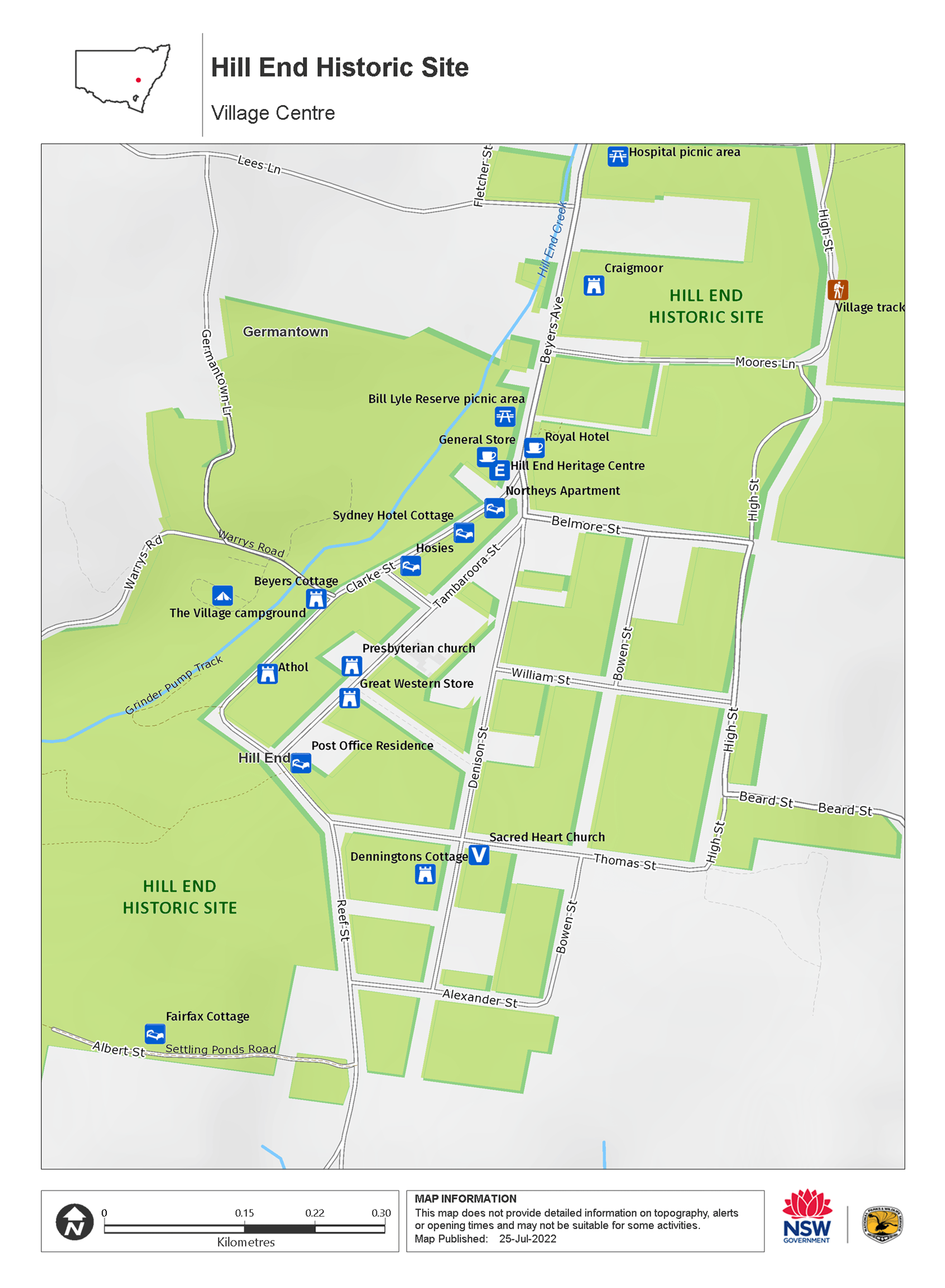
Map legend

Contact
- in the Country NSW region
Hill End Historic Site is always open but may have to close at times due to poor weather or fire danger.
-
-
Hill End Historic Site office
02 6370 9050
Contact hours: Monday to Friday, 8am to 4pm. Closed weekends and public holidays. - 5 Beyers Avenue, Hill End NSW 2850
-
Email: hill.end@environment.nsw.gov.au
-
Hill End Historic Site office
-
-
Mudgee office
02 6370 9000
Contact hours: Monday to Friday, 9am to 4:30pm. - 27 Inglis Street, Mudgee NSW 2850
-
Email: npws.mudgee@environment.nsw.gov.au
-
Mudgee office
Visitor info
All the practical information you need to know about Hill End Historic Site.
Getting there and parking
From Bathurst (allow 1.5hrs)
- Turn off the Great Western highway onto Gilmour St at Kelso
- Follow Sofala Road for around 45km
- At Sofala, turn left onto Hill End Road and continue for around 37.5km to Hill End Historic Site
From Mudgee (allow 1.25hrs)
- Head north, towards Gulgong on the Castlereagh Highway
- Turn left onto Hill End Road and continue for around 69km to Hill End Historic Site
Parking Show more
- Bald Hill tourist mine See on map
- Beaufoy Merlin lookout See on map
- Bill Lyle Reserve picnic area See on map
- General Store See on map
- Hill End Pines Cottage See on map
- Sydney Hotel Cottage See on map
Vehicle access
- 2WD vehicles
Weather restrictions
- All weather
By bike
Check out the Bicycle information for NSW website for more information.
Best times to visit
There are lots of great things waiting for you in Hill End Historic Site. Here are some of the highlights.
Autumn
With sunny, dry days and crisp evenings, it's a great time of year for a camping holiday at Hill End – head to the Village campground or the larger Glendora campground. You could even sign up as a campground host.
Spring
Flowers are at their best this time of the year - enjoy cherry blossoms and blooms in the historic cottage gardens.
Winter
The winter light is renowned among artists and photographers - you may even get some shots of snow .
Weather, temperature and rainfall
Summer temperature
Average
15°C and 27°C
Highest recorded
40.1°C
Winter temperature
Average
1°C and 15°C
Lowest recorded
-8.9°C
Rainfall
Wettest month
January
Driest month
April and May
The area’s highest recorded rainfall in one day
108.7mm
Facilities
Amenities
Toilets Show more
- Bald Hill tourist mine
- Bill Lyle Reserve picnic area
- Fairfax House
- General Store
- Glendora campground
- Hill End Pines Cottage
- Hosies
- Northeys apartment
- Post Office Residence and Stables
- Sydney Hotel Cottage
- Village campground
Picnic tables Show more
- Bald Hill tourist mine
- Bill Lyle Reserve picnic area
- Glendora campground
- Northeys apartment
- Sydney Hotel Cottage
- Village campground
Barbecue facilities Show more
Cafe/kiosk
Drinking water Show more
- Bald Hill tourist mine
- Bill Lyle Reserve picnic area
- Fairfax House
- General Store
- Glendora campground
- Hill End Pines Cottage
- Hosies
- Northeys apartment
- Post Office Residence and Stables
- Sydney Hotel Cottage
- Village campground
Public phone
Showers Show more
- Fairfax House
- Glendora campground
- Hill End Pines Cottage
- Hosies
- Northeys apartment
- Post Office Residence and Stables
- Sydney Hotel Cottage
- Village campground
Electric power Show more
Maps and downloads
Permitted
Pets
You can walk your dog on-lead at this location. See other regional parks in NSW that have dog walking areas.
- You will need to keep your dog on a leash at all times and remember to pick up after them.
- Dangerous dogs and restricted breed dogs as defined under the Companion Animals Act must be muzzled at all times.
- Dogs are not permitted inside buildings or on tours (other than certified assistance animals).
- Dogs are not allowed within 10m of barbecues, picnic tables and children's playgrounds.
Prohibited
Drones
Flying a drone for recreational purposes is prohibited in this area. Drones may affect public enjoyment, safety and privacy, interfere with park operations, or pose a threat to wildlife. See the Drones in Parks policy.
This area may be a declared Drone Exclusion Zone, or may be subject to Civil Aviation Safety Authority (CASA) rules for flying near airports, aerodromes and helicopter landing sites. See CASA's Drone Flyer Rules.
Commercial filming and photography
Commercial filming or photography is prohibited without prior consent. You must apply for permission and contact the local office.
Smoking
NSW national parks are no smoking areas.
Nearby towns
Mudgee (71 km)
Set in the Cudgegong River valley in Central West NSW, Mudgee is a charming historic town and a popular destination for wine enthusiasts keen to sample its award-winning reds and whites. From its many wineries and national parks to markets, festivals and activities for the kids, Mudgee has much to offer.
Bathurst (80 km)
Within a 70-km radius of Bathurst are the spectacular limestone cave systems -Abercrombie and Jenolan caves - which you can explore safely on guided tours.
Orange (135 km)
The bustling city of Orange, with its many cafes, restaurants and shopping opportunities, has something for everyone, plus there's a huge range of places to stay. The real highlight is the town's food and wine, so bring your thirst and your appetite.
Learn more
Hill End Historic Site is a special place. Here are just some of the reasons why:
A past to cherish
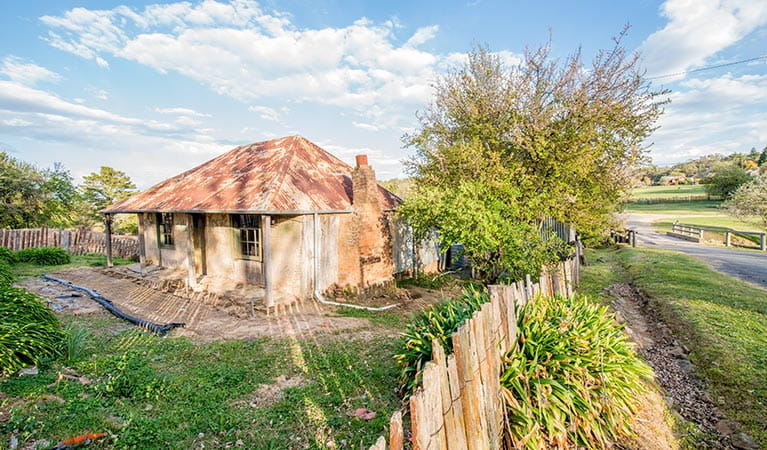
Artists have long gravitated to picturesque Hill End. Since the Second World War the scarred landscape has drawn artists such as Russell Drysdale, Donald Friend, John Olsen and Brett Whiteley to capture the striking scenery on canvas. The Hill End Artist in Residence Program is run by Bathurst Regional Art Gallery and continues this tradition, offering contemporary artists an opportunity to make the pilgrimage to Hill End. Take a walk in the same landscape that has moved so many artists. Please note: Selected works from the program previously on display at the Jean Bellette Gallery in the Visitor’s Centre, will be re-located to a new venue at a date to be advised.
The gold rush hit nearby Bathurst in 1851 and Hill End, swept up in the frenzy, was settled in 1852. It wasn’t until almost 20 years later, however, that large-scale mining began. After most of the mining population had moved on, it was the Gold Centenary Celebrations in 1951 that were the catalyst for Hill End being recognised for its significant heritage value.
- Capertee and Hill End 4WD camping tour Explore the stunning sights of Capertee, the Turon River and Hill End on a 4WD camping adventure with Adrenalin Offroad Centre.
- Cornish Quartz roasting pits The quartz roasting pits are a short drive from Hill End and are a significant historical remnant of Australia’s earlier mining heritage.
- Craigmoor House Step back in time at heritage Craigmoor House in Hill End Historic Site. Home to the Marshall family for nearly a century, this lovingly preserved building has fascinating tales to tell about life in a mining town during colonial times.
- Denningtons Cottage Denningtons Cottage is a heritage miner’s cottage built in 1858 in Hill End, and now home to ceramic artist studio.
- Hill End gold 4WD adventures Hop on board a comfortable 4WD vehicle and enjoy a thrilling journey over rugged 4WD trails as you explore the Hill End and Sofala goldfields region. These excursions with Simmo’s Offroad Tours are a great way discover fascinating gold rush history and heritage.
Mine for gold
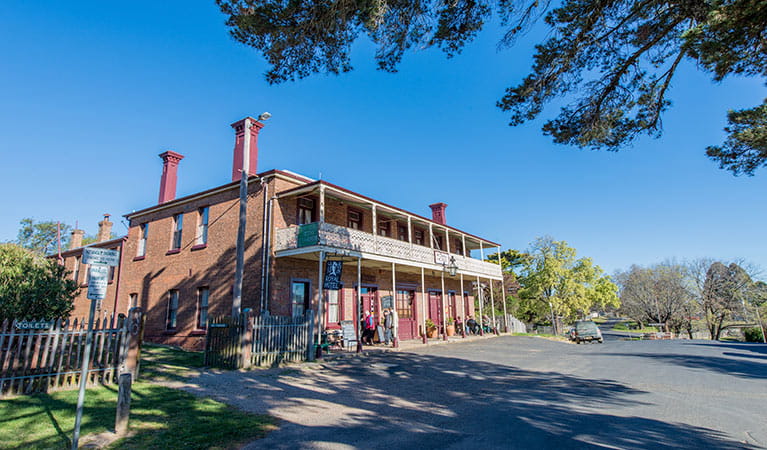
Ever wondered how gold is separated from the rock it’s found in? Or want to know what a steam boiler or battery stamp’s used for? Hill End is full of places where you can learn all about mining gold. Visit the Colonial Gold Mining Company’s roasting kilns and battery buildings, enjoy a barbeque at the grounds of the Historic Hill End Hospital, check out the impressive collection of carriages and work machinery from the gold rush era housed close by, and don’t forget to book one of the many tours available while you’re there to make the most of your visit.
- Bald Hill tourist mine Experience the underground world of a goldminer at Bald Hill tourist mine. A short walk or drive from Hill End, this guided tour is ideal for families and school groups.
- Beaufoy Merlin lookout Beaufoy Merlin lookout offers spectacular views and an excellent vantage point to see the true scale of former mining activities. It’s also great for photography.
- Hill End Heritage Centre Hill End Heritage Centre's interactive museum displays and historic information are the perfect introduction to any visit to Hill End Historic Site.
Plants and animals protected in this park
Animals
-
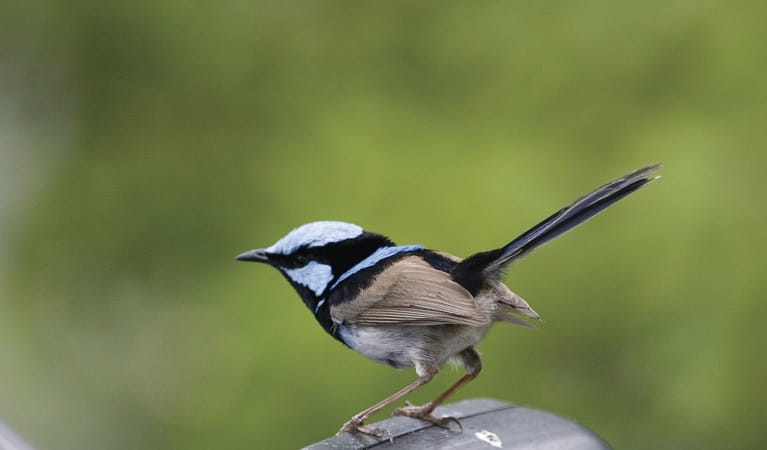
Superb fairy wren (Malurus cyaneus)
The striking blue and black plumage of the adult male superb fairy wren makes for colourful bird watching across south-eastern Australia. The sociable superb fairy wrens, or blue wrens, are Australian birds living in groups consisting of a dominant male, mouse-brown female ‘jenny wrens’ and several tawny-brown juveniles.
Environments in this park
Education resources (1)
What we're doing
Hill End Historic Site has management strategies in place to protect and conserve the values of this park. Visit the OEH website for detailed park and fire management documents. Here is just some of the work we’re doing to conserve these values:
Managing weeds, pest animals and other threats
Pests and weeds have an impact to biodiversity of Hill End Historic Site. Pest reduction of introduced species, as well as risk assessment for new and emerging weeds, is an important part of the work NPWS does to protect the biodiversity of this historic site.
Historic heritage in our parks and reserves
The historic heritage of Hill End Historic Site is preserved through a variety of NPWS programs that embrace its colonial past. Heritage revitalisation, sustainable adaptive reuse and history interpretation projects are ongoing in this park.
Developing visitor facilities and experiences
NPWS is dedicated to ensuring visitors have positive, memorable experiences in NSW national parks. In keeping with this, historically significant tourist accommodation and other visitor facilities in Hill End Historic Site receive progressive restoration and are maintained to a high standard.
Managing fire
NSW is one of the most bushfire prone areas in the world as a result of our climate, weather systems, vegetation and the rugged terrain. NPWS is committed to maintaining natural and cultural heritage values and minimising the likelihood and impact of bushfires via a strategic program of fire research, fire planning, hazard reduction, highly trained rapid response firefighting crews and community alerts.
General enquiries
- National Parks Contact Centre
- 7am to 7pm daily
- 1300 072 757 (13000 PARKS) for the cost of a local call within Australia excluding mobiles
- parks.info@environment.nsw.gov.au
Contact
- in the Country NSW region
Hill End Historic Site is always open but may have to close at times due to poor weather or fire danger.
-
-
Hill End Historic Site office
02 6370 9050
Contact hours: Monday to Friday, 8am to 4pm. Closed weekends and public holidays. - 5 Beyers Avenue, Hill End NSW 2850
-
Email: hill.end@environment.nsw.gov.au
-
Hill End Historic Site office
-
-
Mudgee office
02 6370 9000
Contact hours: Monday to Friday, 9am to 4:30pm. - 27 Inglis Street, Mudgee NSW 2850
-
Email: npws.mudgee@environment.nsw.gov.au
-
Mudgee office
In this park:
Things to do (20)
- 4WD touring (2)
- Birdwatching and wildlife encounters (2)
- Cafes and kiosks (2)
- Educational activities (1)
- Historic heritage (17)
- Other experiences (1)
- Picnics and barbecues (2)
- Sightseeing (4)
- Visitor centres (1)
- Walking (3)

